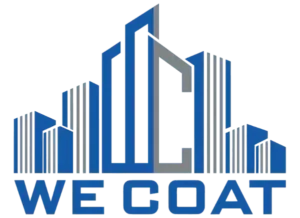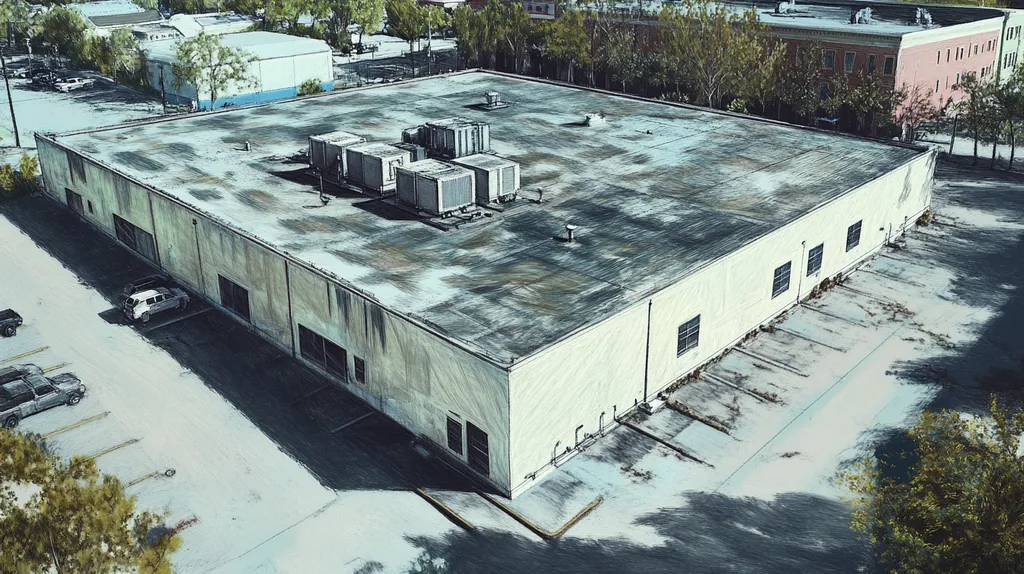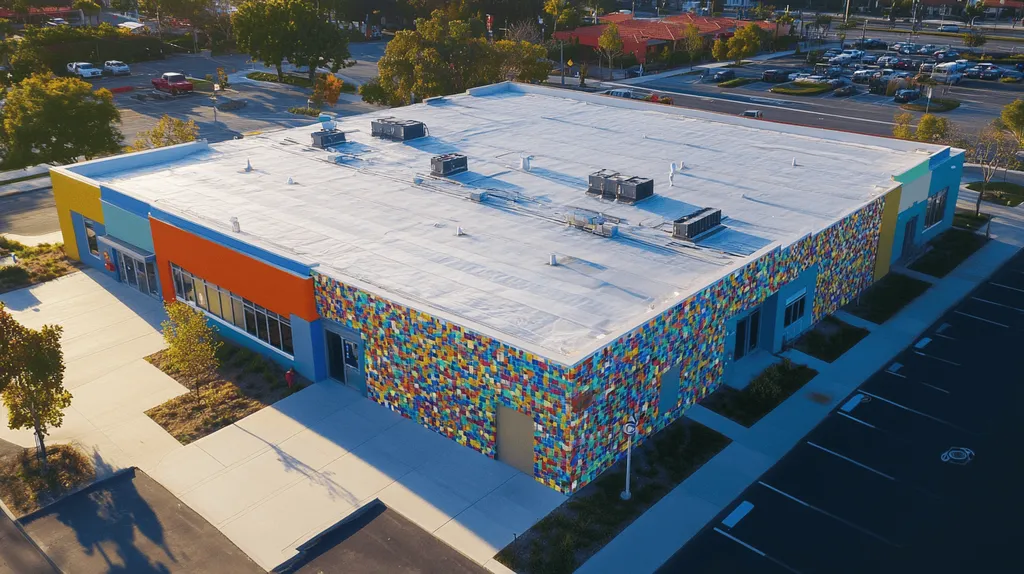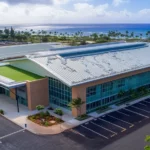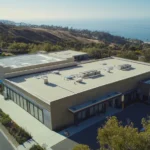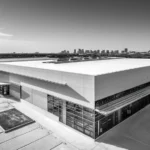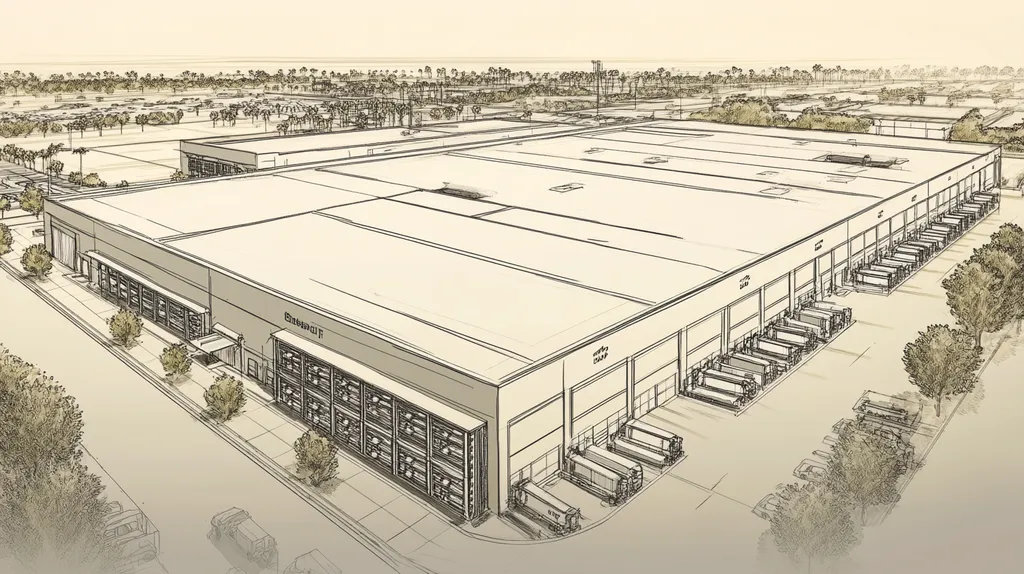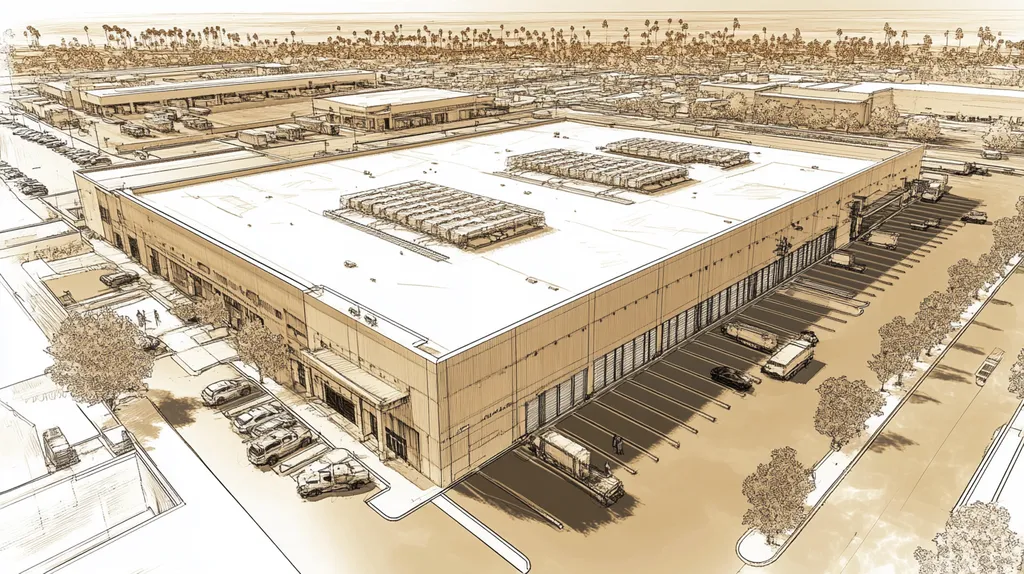With commercial buildings consuming over 35% of U.S. electricity and energy costs rising sharply, property owners face mounting pressure to reduce cooling expenses. Reflective roof coatings represent a proven solution, capable of slashing cooling costs by 20-30% while extending roof lifespans.
This comprehensive guide examines the science behind reflective coatings, from material selection to performance metrics. Property managers will discover how these systems work, implementation best practices, and strategies to maximize long-term energy savings.
By understanding reflective coating fundamentals, compatibility requirements, and maintenance protocols, facility leaders can make informed decisions that significantly impact their building’s efficiency and operating costs.
SECTION 1: FUNDAMENTAL CONCEPTS
As energy prices soar, selecting the right roofing options has never been more critical for property owners and facility managers. Reflective roof coatings offer an effective way to cut energy costs while increasing the durability of a building’s roof. Research reveals that reflective roofs can lower cooling expenses by an impressive 20-30%. Grasping the essential concepts behind these coatings is vital for making educated decisions that benefit both finances and the environment.
What Are Reflective Roof Coatings?
Reflective roof coatings are advanced materials specifically designed to bounce back solar radiation. Unlike conventional roofs that absorb heat, these coatings keep surface temperatures lower by reflecting the sun’s rays. This feature is particularly advantageous in warmer regions, where energy costs for cooling can escalate quickly.
Made typically from a polymer base combined with reflective additives, these coatings can be applied to multiple roofing types, allowing for great flexibility in commercial settings. By opting for reflective coatings, property owners can significantly boost the efficiency of their current roofs without needing a complete overhaul.
Additionally, these coatings can prolong the lifespan of a roof. By minimizing thermal stress on the roofing material, they help prevent degradation caused by extreme temperatures. This strategic investment not only offers immediate savings but also ensures long-term benefits.
Ultimately, understanding reflective roof coatings lays the groundwork for appreciating their energy-saving capabilities. This knowledge empowers property managers to actively manage energy consumption and costs.
Solar Reflectance and Thermal Emittance
Solar reflectance measures how effectively a material can reflect sunlight, while thermal emittance indicates how well a surface can release stored heat. Together, these characteristics define the efficiency of reflective roof coatings. A roof with a solar reflectance rating above 0.70 is deemed very reflective, reducing heat accumulation and consequently lowering air conditioning demands.
For instance, roofs that reflect a significant amount of solar radiation not only maintain lower surface temperatures but also ease stress on cooling systems. When paired with high thermal emittance, which accelerates heat dissipation, these coatings can lead to substantial energy savings.
It’s essential for property owners to evaluate both solar reflectance and thermal emittance when exploring roofing options. Many conventional materials are deficient in reflectivity, resulting in excessive heat absorption and elevated energy bills. Transitioning to reflective coatings can fundamentally change this trend.
Grasping these principles helps facility managers assess potential energy savings, thus shaping budgetary decisions. By prioritizing roofing materials with strong reflective qualities, property owners can enhance both efficiency and comfort in their buildings.
Energy Efficiency and Environmental Benefits
Energy efficiency is not just a financial strategy; it also carries significant environmental consequences. Reflective roof coatings lead to considerable reductions in energy use, resulting in decreased greenhouse gas emissions. Studies suggest that adopting reflective roofing widely could alleviate the urban heat island effect, which exacerbates local temperatures.
Furthermore, less energy use diminishes dependence on fossil fuels, a key component for achieving a sustainable future. Property owners can serve as proactive custodians of the environment while improving their financial standing. Investing in reflective coatings not only yields immediate cost savings but also bolsters environmental health.
Moreover, energy-efficient buildings often attract higher occupancy rates. Today’s tenants are increasingly drawn to spaces that prioritize sustainability. This growing market preference makes energy-efficient roofs an appealing selling point, thereby enhancing investment returns.
In conclusion, utilizing reflective roof coatings can significantly enhance energy efficiency and promote sustainability. Understanding these advantages equips property owners and facility managers to make informed decisions that align with both economic and ecological goals.
SECTION 2: SYSTEM COMPONENTS
Understanding the components that make up reflective roof coatings is crucial for maximizing energy savings. With energy prices on the rise, property owners are increasingly pressured to find solutions that reduce costs without compromising building integrity. Reflective coatings can considerably decrease energy consumption, but their success relies on selecting the best materials and formulations. This section delves into the various types of reflective coating materials, explores their specific formulations and properties, and examines how they integrate with existing roofing systems.
Types of Reflective Coating Materials
Reflective coatings are available in several forms, each engineered to meet distinct performance standards. Common materials include acrylics, polyurethanes, and silicates. Acrylic coatings are particularly popular due to their water-based nature and excellent UV reflectivity, often achieving reflectivity values in the low 90 percent range. On the other hand, polyurethane coatings are praised for their exceptional durability and weather resistance, making them a strong choice for harsh environments.
Silicate coatings offer outstanding adhesion and thermal stability, which can enhance roof longevity. Each material comes with unique properties affecting its lifespan, flexibility, and ease of application. Selecting the appropriate type is critical since it directly impacts energy savings and the overall performance of the roof.
Additionally, some coatings are tailored for specialized applications. For example, options featuring embedded reflective particles can dramatically improve thermal performance, resulting in lower heat absorption. Therefore, the selection process should be guided by the building’s specific needs and climate considerations.
To ensure optimal results, property owners are encouraged to consult with roofing professionals. This collaboration helps identify the best options available, ensuring the selected materials will maximize energy savings and extend the roof’s life.
Coating Formulations and Properties
The effectiveness and longevity of reflective coatings hinge on their formulation. These coatings typically contain resins, pigments, and various additives that enhance their performance. For energy-efficient applications, light-colored pigments are indispensable, significantly boosting solar reflectivity.
Additives can also improve resistance to mildew, UV degradation, and thermal expansion, essential for maintaining performance in varying environmental conditions. A well-formulated reflective coating can last up to 20 years, providing long-term energy savings and operational efficiency.
Moreover, application thickness is vital; coatings that are overly thin may fail to deliver proper insulation or reflective capacities. In contrast, high-build formulations can offer superior durability but often come with a higher initial expense.
Property owners should weigh both their upfront investment and potential long-term energy savings when evaluating different formulations. A solid understanding of these properties is necessary to make informed decisions that safeguard financial interests.
Compatibility with Existing Roofing Systems
Compatibility plays a pivotal role when applying reflective coatings to existing roofing systems. Not all coatings can be universally applied; mismatches can lead to failure and costly repairs. Property owners must first assess the condition and type of their current roofing material.
For instance, many acrylic coatings are known to adhere effectively to built-up roofs, while polyurethane options are often best suited for single-ply systems. It’s crucial that any cleaning or preparatory work performed on the roof does not compromise the underlying material.
Understanding warranty implications is also essential, as applying non-compatible coatings may void certain manufacturer warranties. This highlights the importance of consulting with roofing experts who can recommend products that suit existing systems.
Ensuring compatibility not only preserves the roof’s structural integrity but also supports the energy-saving goals associated with reflective coatings. Property owners must prioritize this evaluation to optimize both the efficiency and longevity of their roofing investments.
SECTION 3: IMPLEMENTATION METHODS
Applying reflective coatings is a pivotal step in enhancing energy efficiency for commercial roofs. The potential for significant energy savings is substantial, but ineffective implementation can lead to costly repercussions. Thoroughly inspecting and preparing the roof is essential to unlock the full benefits of these coatings. Additionally, mastering application techniques and establishing quality assurance measures are critical components for successful implementation.
Pre-Application Roof Inspection and Preparation
Before any reflective coating is applied, a meticulous roof inspection is imperative. This assessment uncovers any existing problems—like leaks or surface damage—that could impair adhesion. Property owners should enlist qualified roofing professionals for a thorough evaluation of the roof’s structural integrity and condition.
Preparation involves a comprehensive cleaning of the roof surface to eliminate dirt, debris, or remnants of previous coatings. Depending on the roofing material, high-pressure washing or specialized cleaning solutions may be necessary. Ensuring the surface is completely dry before application is crucial for optimal bonding.
Moreover, necessary repairs should be completed ahead of applying the coating. Whether fixing leaks or replacing damaged sections, addressing these issues guarantees that reflective coatings will adhere properly and perform effectively over time.
Lastly, engaging with coating manufacturers can help tailor products to specific roof types, ensuring the selected reflective coatings align with the property’s unique needs and maximize energy savings.
Application Techniques and Tools
Applying reflective coatings effectively requires specific techniques and tools to ensure even coverage and maximum efficacy. Common methods include spray, brush, or roller applications, with each choice tailored to the roof surface and coating material.
Spray application allows for quick coverage, especially on complex roof shapes. However, it necessitates skilled technicians to prevent overspray and guarantee consistent application. In contrast, brush and roller methods provide more control for detailed areas but take longer to complete.
The right equipment is vital for successful application. High-quality sprayers, brushes, and rollers enhance the coating’s performance. Additionally, monitoring temperature and weather conditions during application is key to achieving proper curing and bonding.
Detail-oriented application significantly influences the coating’s longevity. Technicians should adhere to the manufacturer’s guidelines for dry film thickness to secure optimal energy reflectivity. Consistent application directly impacts energy savings and reduces long-term maintenance expenses.
Quality Assurance and Final Inspection
Once the reflective coating is applied, implementing quality assurance measures is crucial. A thorough final inspection verifies that all application processes were executed correctly and identifies any areas in need of touch-ups. This step is vital for ensuring the coating’s performance and longevity.
The final inspection should assess coverage uniformity and check for issues like peeling, bubbling, or missed spots. Any defects found must be promptly addressed to prevent future energy losses. A meticulous final inspection can save property owners from costly repairs later.
Documenting the entire application process—including inspection reports and maintenance recommendations—is vital. This documentation acts as a reference for future maintenance and helps assess the return on investment in energy savings.
Finally, scheduling regular maintenance checks can ensure that the reflective coating remains intact and effective over time. Such proactive measures help sustain energy savings and protect the roof’s structural integrity for years to come.
SECTION 4: MAINTENANCE REQUIREMENTS
Regular maintenance is crucial for preserving the energy savings provided by reflective roof coatings. Studies suggest that neglected roofs can lose as much as 15% of their reflective properties each year due to dirt accumulation and damage. By prioritizing maintenance, property owners can maximize energy efficiency and protect their investment in these coatings. This section highlights essential maintenance strategies, covering inspection, cleaning, repair, and preventative measures.
Regular Inspection and Monitoring
Conducting regular inspections is key to ensuring the effectiveness of reflective roof coatings. Property owners should schedule inspections at least twice a year, ideally in the spring and fall. Such inspections can reveal issues like surface wear, discoloration, or damage that may compromise the roof’s reflective properties.
During inspections, professionals should evaluate the overall roof condition and look for areas of concern. Utilizing infrared thermography can identify heat buildup, signaling hidden problems that are otherwise undetectable.
Quick documentation and reporting of any discovered issues will enable timely repairs. By addressing these problems without delay, property owners can avoid expensive repairs later and maintain energy efficiency.
Implementing a monitoring system can further enhance maintenance efforts. Sensors can provide real-time performance data, alerting facility managers about potential issues before they escalate.
Cleaning and Repair Procedures
Cleaning reflective roof coatings is essential for maintaining their energy-saving effectiveness. Accumulations of dirt, algae, and other biological matter can critically reduce a roof’s reflective capabilities. It is advisable to have roofs cleaned at least once a year, with more frequent cleanings in heavily contaminated areas.
When cleaning, non-abrasive techniques should be used to prevent damage to the coating. Soft washing with gentle detergents proves effective and preserves the reflective surface’s integrity.
Immediate repairs following damage discovery are equally important. Even minor issues like cracks or dents can escalate into significant problems if not addressed promptly.
Using the right materials for repairs is crucial. Only manufacturer’s recommended products should be employed to ensure compatibility and efficacy, thereby enhancing the durability of the coating while remaining compliant with warranty requirements.
Preventative Measures Against Damage
Implementing preventative measures can considerably extend the lifespan of reflective roof coatings. Establishing effective drainage systems is essential, as stagnant water can contribute to premature deterioration.
Regular tree trimming is another vital precaution. Overhanging branches pose a threat during storms and may be breeding grounds for pests that could damage the roof.
Facility managers should also inform employees about proper roof usage. Limiting roof access and providing clear signage can prevent unnecessary wear and tear from foot traffic.
Utilizing protective barriers or impact mats in high-traffic areas can further reduce the risk of damage. These straightforward measures work together to maintain the roof’s reflective quality, ensuring lasting energy efficiency.
SECTION 5: PERFORMANCE METRICS
In the face of escalating energy costs and environmental pressures, effectively measuring the performance of reflective roof coatings has become pivotal for commercial property owners. Grasping the metrics of energy savings, reductions in roof temperatures, and the durability of these coatings can lead to substantial impacts on operational budgets. Research shows that well-applied reflective coatings can lower energy consumption by as much as 30%. This section delves into these critical performance metrics, empowering informed decision-making in roofing strategies.
Measuring Energy Savings and Cooling Demand
Quantifying the energy savings from reflective roof coatings is essential for understanding their true value. Conducting energy audits before and after the application of these coatings offers direct comparisons that highlight their effectiveness. In warmer climates, reflective roofs have been shown to reduce cooling energy consumption by 20-30%, providing immediate financial relief.
Utilizing Energy Star benchmarking tools allows property owners to analyze their cooling demand inputs and outputs, offering insights into how reflective surfaces affect energy budgets. These audits can uncover not just savings but also potential rebates and incentives tied to energy-efficient upgrades.
Real-time monitoring systems can further enhance this understanding. By tracking energy usage patterns and comparing them to historical data, facility managers can optimize their strategies and identify peak usage times that inflate costs.
Overall, accurate energy measurement fosters a comprehensive understanding of how reflective coatings drive cooling needs and overall financial performance.
Assessing Roof Temperature Reduction
Roof temperature is vital for assessing a building’s energy efficiency. Reflective roofing systems are specifically engineered to keep surface temperatures significantly lower than traditional materials. Research indicates that these roofs can achieve surface temperature reductions of 30% or more on sunny days.
To accurately gauge these temperature shifts, infrared thermography serves as an invaluable tool. This technology provides visual insights into roof temperatures, enabling property owners to witness the immediate benefits of their investment. Additionally, the data obtained can be useful in advocating for future energy-efficient enhancements.
Cooler roof temperatures also extend roof lifespans. By minimizing thermal expansion and contraction, reflective coatings reduce wear and tear, showing that investing in these solutions curbs energy costs while enhancing the durability of roofing materials.
Overall, monitoring roof temperatures provides clear indicators of the ongoing performance and benefits derived from reflective roof coatings.
Evaluating Long-Term Durability
While the immediate energy savings are significant, the long-term durability of reflective roof coatings is equally important. Quality coatings can endure the challenges posed by weather, UV exposure, and thermal cycling that commercial roofs frequently face. Studies suggest that these high-quality reflective coatings can last a decade or longer with proper maintenance.
Regular inspections are critical for evaluating the coating’s integrity, ensuring that property owners identify issues such as adhesion loss, cracking, or discoloration early on. A proactive maintenance plan maximizes the roof’s performance, protecting the initial investment.
Additionally, industry certifications can serve as indicators of product durability. Coatings that meet or exceed ASTM standards demonstrate their resilience against environmental challenges over time.
By investing in durable reflective coatings, property owners can minimize the need for repairs and replacements, thereby safeguarding financial resources for more strategic business initiatives.
SECTION 5: PERFORMANCE METRICS
In today’s world of skyrocketing energy costs and increasing environmental pressures, effectively measuring the performance of reflective roof coatings has become crucial for commercial property owners. Understanding key metrics such as energy savings, roof temperature reductions, and long-term durability can significantly impact operational budgets. Research reveals that well-installed reflective coatings can cut energy consumption by up to 30%. This section will delve into these vital performance metrics, providing the insights needed for smart roofing investments.
Measuring Energy Savings and Cooling Demand
Quantifying the energy savings achieved through reflective roof coatings is essential for assessing their true value. Property owners should conduct energy audits both before and after the installation of these coatings to obtain a clear picture of their effectiveness. In warmer climates, studies indicate that reflective roofs can reduce cooling energy consumption by 20-30%, leading to noticeable financial relief.
Utilizing Energy Star benchmarking tools empowers property owners to analyze their cooling demand inputs and outputs. This analysis helps illuminate how reflective surfaces influence overall energy budgets and can uncover potential rebates and incentives tied to energy-efficient upgrades.
Real-time monitoring systems further enhance the understanding of energy use patterns. By comparing these patterns with historical data, facility managers can optimize operational strategies and identify peak usage times that contribute to elevated costs.
Overall, accurate energy measurement leads to a comprehensive understanding of how reflective coatings impact cooling needs and, ultimately, financial performance.
Assessing Roof Temperature Reduction
Roof temperature is a pivotal factor in determining a building’s energy efficiency. Reflective roofing systems are engineered to keep surface temperatures significantly lower than those of traditional roofing materials. Research suggests that reflective roofs can achieve surface temperature reductions of 30% or more on sunny days, directly influencing energy consumption.
Infrared thermography can be utilized to gauge these temperature shifts accurately. This technology provides valuable visual imaging of roof temperatures, helping property owners see the immediate benefits of their investment. The data collected can also be instrumental in advocating for future energy-efficient enhancements.
Additionally, maintaining lower roof temperatures contributes to longer roof lifespans. Cooler surfaces experience less thermal expansion and contraction, leading to reduced wear and tear. Therefore, investing in reflective coatings not only cuts energy costs but also enhances the durability of roofing materials.
Monitoring roof temperatures effectively provides clear indicators of the ongoing performance and benefits of reflective roof coatings.
Evaluating Long-Term Durability
While immediate energy savings are crucial, the long-term durability of reflective roof coatings is equally significant. Quality coatings are designed to withstand challenges posed by weather, UV exposure, and thermal cycling—common stressors in commercial roofing systems. Studies show that high-quality reflective coatings can last a decade or longer when properly maintained.
Regular inspections are essential for assessing the coating’s integrity. These inspections should focus on potential issues such as adhesion loss, cracking, or discoloration. Implementing a proactive maintenance plan ensures that the roof remains effective, enabling property owners to maximize their investment.
Industry certifications can serve as indicators of a product’s durability. For instance, coatings that meet or exceed ASTM standards prove their resilience to various environmental challenges over time.
By investing in durable reflective coatings, property owners can minimize the need for frequent repairs and replacements, preserving capital for other strategic business initiatives.
Looking Ahead
With energy costs projected to rise 30% over the next decade, reflective roof coatings represent a critical opportunity for commercial property owners to protect their bottom line.
These advanced systems have consistently demonstrated 20-30% reductions in cooling costs while extending roof lifespans by up to 10 years.
The technology, testing methods, and implementation strategies detailed in this guide provide a clear roadmap for facility managers to capture these benefits.
As building efficiency standards become increasingly stringent and energy prices continue climbing, reflective coatings will play an essential role in future-proofing commercial properties.
The time for property owners to act is now – before rising costs and tightening regulations force their hand.
FREQUENTLY ASKED QUESTIONS
Q. What are reflective roof coatings?
A. Reflective roof coatings are advanced materials designed to reflect solar radiation. Unlike conventional roofs, these coatings keep surface temperatures lower, significantly reducing energy costs for cooling. They can be applied to various roofing types, enhancing efficiency without complete replacements.
Q. What types of commercial roof coatings are available?
A. There are multiple types of reflective coatings, including acrylics, polyurethanes, and silicates. Each material has distinct advantages, such as UV resistance or durability, and the best choice depends on your building’s specific needs.
Q. How should I prepare my roof before applying reflective coatings?
A. Before application, perform a thorough roof inspection to identify any damage. Clean the surface to remove debris, and ensure the roof is completely dry. Address any existing issues to guarantee the coating adheres properly.
Q. Why is regular maintenance important for reflective roof coatings?
A. Regular maintenance is vital to preserve reflective coatings’ energy-saving abilities. Dirt accumulation and damage can lead to reduced efficiency. Scheduling inspections and cleanings helps maintain the coating’s effectiveness and extends its lifespan.
Q. How can I measure the energy savings from reflective roof coatings?
A. Conducting energy audits before and after applying reflective coatings can quantify savings. Monitoring cooling demand and utilizing benchmarking tools helps assess how these coatings impact overall energy use and costs.
Q. What are the common performance metrics for reflective coatings?
A. Key performance metrics include energy savings, roof temperature reduction, and durability. Analyzing these factors helps property owners understand the value of reflective roof coatings and supports informed decision-making.
Q. Are there any rebates available for installing reflective roof coatings?
A. Yes, many regions offer rebates or incentives for installing energy-efficient features like reflective roof coatings. Reviewing local utility programs and government initiatives can provide valuable financial benefits for such upgrades.
